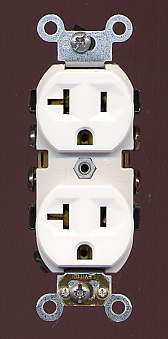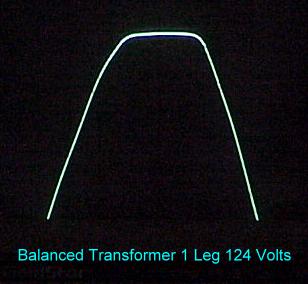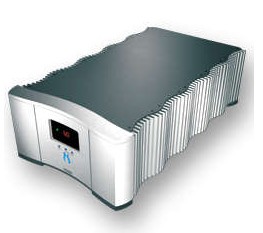Product Review - PS Audio P1200 Power Plant AC Generator - June, 2001
John E. Johnson, Jr.
![]()
|
|
Specifications Maxiumum Current Supply: 20 Amperes Output Sockets: Eight Grounded (The 120 Volt Input is IEC) Dimensions: 9" H x 17" W x 30" D Weight: 155 Pounds MSRP: $3,995 USA |
|
PS Audio, 3050 Broadway, Boulder, Colorado 80304; Phone 720-406-8946; Fax 720-406-8967; E-Mail [email protected]; Web http://www.psaudio.com/ |
Introduction
Last year, at our first annual Benchmark Event, we tested more than a dozen DVD players. We had on hand a PS Audio P300 Power Plant AC Line Conditioner, called Generator by PS Audio, and we compared the noise floor of all the DVD players when plugged into the wall AC vs. being plugged into the P300. In just about every case, the noise floor was vastly improved with the P300. This was actually some of the very first conclusive proof that line conditioners really do work. Ever since those first tests, I have been very much looking forward to having the P1200, which will handle much heavier loads of components than the P300 or P600. About a month ago, I received one.
The P1200 is an enormous product. It arrived strapped to a wooden plat that is used by fork lifts to move it around. After un-strapping it, and using a hand truck to get it into our home theater lab, I unpacked it. The box contains two pairs of studded gloves so that it can be lifted and moved without hurting your hands. There are two pairs because it takes two people to handle it. It is a real beast. We placed it next to one of our easy chairs (see below). Note the silicone door bumpers that we put under the P1200. Under the bumpers are Teflon discs. This allows for sliding the P1200 anywhere we want on the wooden floor. You can get these items at hardware stores, such as Home Depot. I recommend them for a product like this. They can save you a trip to the chiropractor.

The P1200 is wired for connection to a 20 amp socket, meaning that you will probably need to buy one at Home Depot (about $4). Here is what they look like (two-socket photo below). It has to be grounded, which may be a problem in very old houses. Having grounded outlets is a good idea anyway, so just get it all done before you bring the P1200 home. PS Audio recommends that the circuit be 30 amp rated, but we did not experience any problems having it connected to a 20 amp circuit.

The incoming 120 Volt AC connection to the P1200 is another odd item, called a Neutrik NAC3FCA Powercon. However, the AC cable is supplied, and if you have ever connected a BNC plug to something, it works pretty much the same way. Push it in and twist to lock it. I wish all AC products had this type of connector. The more typical ones we are used to can come loose.
The rear panel of the P1200 has eight sockets for output. Four of them are standard types like we have in our walls. The other four are Neutrik Powercon (see photo below).

The Technology
The principle basis of operation of the PS Audio Power Plant series (P300, P600, P1200) is a two-channel fully balanced audio amplifier. The incoming AC goes to a power supply (transformers, rectifier diodes, and capacitors), where it is converted to DC. The output of the power supply goes to an input stage, driver stage, and output stage, just like any audio amplifier. The difference is that instead of having an input for a line-level music signal, the Power Plants use a digital oscillator to generate a 60 Hz sine wave, and that is fed to the amplifier. Lots of negative feedback is used to keep the output at 120 Volts, regardless of the demands placed on the Power Plant. So, the difference between the AC coming out of the wall, and the AC going to your Hi-Fi components from the P1200 is that there is only one frequency - 60 Hz - and the voltage does not drop, even if you have massive subwoofers plugged into it, like I did when I tested it. So, the P1200 acts as a voltage regulator besides generating clean AC.
The idea behind cleaning up the AC this way is that no filter can really get rid of all the crud that wall AC has. We are all connected to miles and miles of AC wires that hang from telephone poles, up there where they can act as antennae for everything that is being sent from TV and radio transmitters, cell phones, and outer space for that matter. They also include whatever noise that your own refrigerator is producing, along with your neighbor's. So, instead of just trying to filter all that stuff out, the PS Audio turns all the AC from the wall into DC, and regenerates the 60 Hz 120 Volts from scratch.
The P1200 does offer something they call MultiWave. This allows you to alter the sine wave output so that it contains harmonics of pre-determined frequencies, but not necessarily all at the same time. For example, selecting from the front panel, you can have SS1 (50 Hz followed by two 120 Hz), PS2 (60 Hz with 180 Hz), SS3 (50 Hz followed by two 90 Hz), and several other combinations, for a total of ten MultiWave patterns. None of these, however, are recommended with components that have fans, such as some power amplifiers and projectors, or with turntables. Since we had several components with fans, we stuck to the simple sine wave at 60 Hz. Jason Serinus, in his review of MultiWave for the P600, found two patterns to give him the most desired sound in his tubed amplifier setup. I adjusted the output voltage to 117 Volts, where I am most comfortable. I noticed that the wall socket voltage varied all over the place, from 124 Volts on occasion, to 112 Volts during demanding movie passages. The P1200 output never strayed from 117 Volts (the front panel reads out the voltage when you select that option, and I measured the actual voltage with our digital volt-ammeter to be within about 0.7 Volts from what the panel said).
The voltage readout on the panel when MultiWave is used does contrast with what I measured. With some of the patterns, our volt-ammeter read upwards of 123 Volts even when the panel said 117. Although our volt-ammeter might be fooled by the unusual waveforms, I would suggest that you get yourself an inexpensive voltmeter at Radio Shack and measure the output voltage when using the various patterns. You might want to set the P1200 at 112 Volts or so when using the various patterns, so that your measured readout does not exceed 120 Volts, which might extend the life of projector bulbs and tubes. The wattage output reading on the P1200 also appears to read about 25% lower than actual output, and Paul McGowan at PS Audio told me this has something to do with the power factor, which they set at 0.75.
The P1200 became quite warm when we had all the components connected and were watching movies. However, the fan on the rear panel did not come on, indicating that it might run even warmer at times. The unit draws about 0.5 amperes at idle (P1200 turned on but no hi-fi components that are plugged into it being turned on). So, that is about 60 watts at 120 Volts. Depending on the power factor of the hi-fi component plugged into it, the efficiency of the P1200 is 60% - 70%, meaning that if the hi-fi components plugged into it are drawing 600 watts total, the P1200 is taking 1,000 watts from the wall AC socket. This is typical for an audio amplifier. It is not very efficient, but then again, neither is a Ferrari.
Here are some photos from an oscilloscope (see below), showing what the output of our wall AC looks like, compared to the output of the P1200. Notice that the P1200 60 Hz is absolutely clean. No harmonics, no anything but 60 Hz.
 |
 |
 |
The wall AC has a small spike (green arrow) and a bulge on one side (red arrow). These represent noise and harmonics. There is other noise in there too, but it is beyond the resolution of this photo. The P1200 removes the noise and harmonics, period. I also tested a very excellent balanced transformer, which does not regenerate AC, to compare with the P1200. The photo on the far right shows the results. It filtered out the spike, and most of the bulge, but left some of the harmonics, indicated by the flattened top of the waveform. So, a balanced transformer does a pretty good job, and we will be publishing a review of one of the best out there in a couple of weeks (balanced AC has several benefits). The output of the P1200 is very close to being balanced, but not perfectly. I measured about 1 Volt difference between each hot leg and ground (e.g., 58 Volts on one leg and 59 Volts on the other, referenced to ground). The output ground is connected to the input ground, but you can disconnect the output ground and reconnect it to an isolated ground in your yard if you like (pounding a ground spike deep into the earth). This will help remove any residual noise from the house AC wiring. Consult PS Audio for full instructions on the procedure.
At our recent Benchmark Event held in June, 2001, we used a P300 to test the noise floor of 19 DVD players, as measured on an Audio Precision System 2. Shown below is an example from a Panasonic player. On the left is the noise floor when using the wall AC, and on the right is the noise floor when the player was plugged into the P300. Notice the astonishing improvement.
|
|
|
The Sound
The P1200 is rated at 1,200 watts continuous output, and will handle 2,000 watts on a short term basis (such as an explosion in a Stallone movie). I decided that for $3,995, it will have to do everything, so I plugged in our entire home theater system, including a Sony VPL-VW10HT LCD Front Projector, Yamaha DSP-A1 Receiver, Yamaha SD-6200 DVD Player, Cinepro 3k6 SE Gold Power Amplifier (I used five of the six available channels operating at 425 watts per channel), and six (!!) subwoofers (five Velodynes and one Mirage). By golly, I thought, we will find out if the P1200 can handle the pedal to the metal.
The first thing I did was use a digital volt-ammeter to measure the current flow in our system, with heavy duty movies playing, and the volume cranked up. At idle (projector at standby mode), about 5 amps were being used by the audio system (turned on but no movie or music playing). I was surprised to find that only 9 amps flowed to the entire system (projector on) even when "True Lies" was on, and the whole house was shaking. When I connected the ButtKicker into the system, 17 amps flowed, so I decided not to put that little item into the P1200 circuit. What this tells us though, is that the P1200 should handle just about any home theater you can possibly imagine.
The effect of having the P1200, and clean AC, for all our audio equipment was fantastic. The slightly harsh edges in the sound that had been there previously were gone. The ground loop problems were gone. No buzzing, no humming, no nothing but crystal clear audio. We could crank up the sound all we wanted and still maintain a pleasant experience. The irony is that an expensive product like the P1200 may very well have its best effect on the least expensive components, like mass market products. Those components are most likely to have modest power supplies that don't filter out all the AC hash. Such noise interferes with the music waveform, doing such things as beating (this is where two frequencies are very close together).
I also felt the P1200 cleaned up the video signal a bit, meaning that there was an apparent reduction in the video noise I could see in the background. This will result in better blacks, where the noise is most visible, but I had no instrument to actually measure it.
The improvement in audio, on the other hand, was very noticeable. I could not tell if the audio detail was improved, but the reduction in harshness was obvious, and this makes such a marvelous difference when watching action movies. I also listened to some DTS surround CDs, and the harshness was gone too. I had previously thought that this harshness was just due to the compression in DTS and DD, but I was pleasantly surprised to find it had been something in the overall audio system, and quite correctible with the P1200.
Conclusion
I am delighted to give the P1200 my highest recommendations and congratulations. The PS Audio Power Plant series might just very well deliver the cleanest AC on the planet!
- John E. Johnson, Jr. -
© Copyright 2001 Secrets of Home Theater & High Fidelity
Return to Table of Contents for this Issue.




